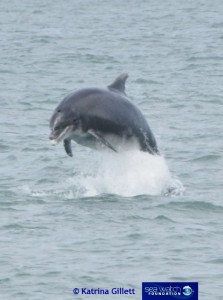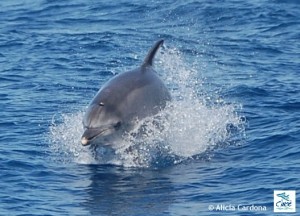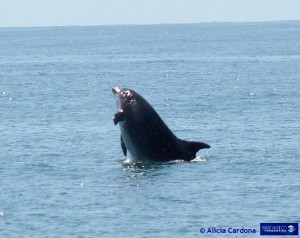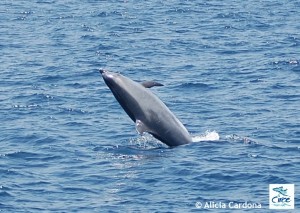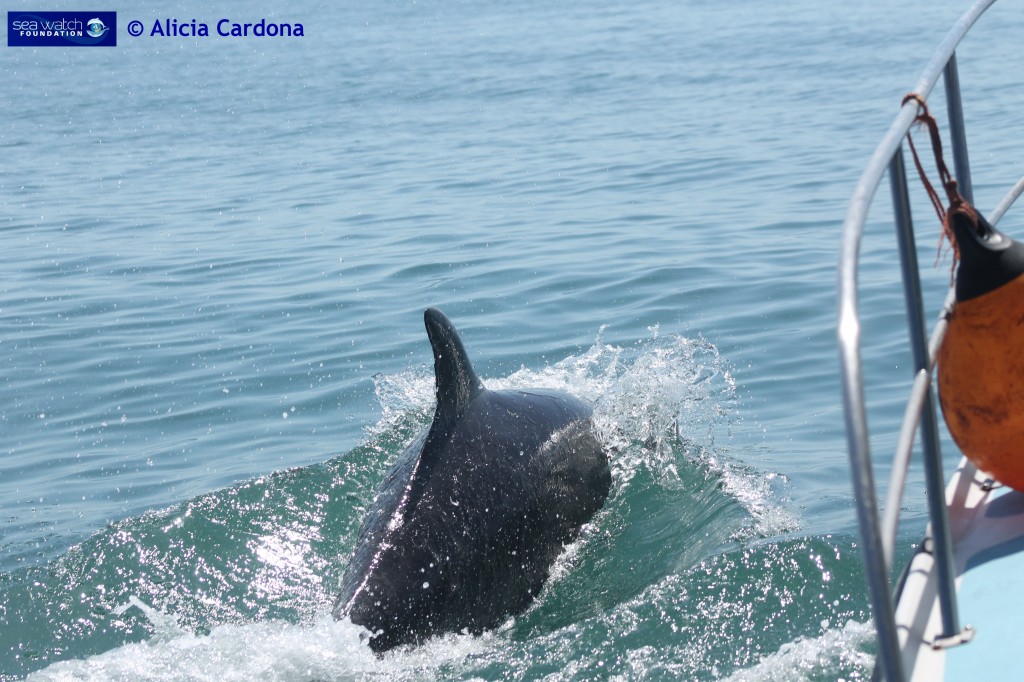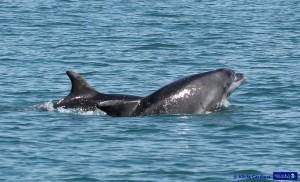Geographical Variations In Bottlenose Dolphins (Tursiops truncatus)
When I first saw bottlenose dolphins in the UK something about their physical appearance caught my attention: these were much bigger, robust and dark animals than any other bottlenose dolphins I had seen so far in coastal areas of the Mediterranean and Strait of Gibraltar.
Left: bottlenose dolphin seen in New Quay (Wales). Above: bottlenose dolphin I saw in the Strait of Gibraltar, which as you can see from the pictures is slimmer and lighter in colour and it was smaller in size.
Bottlenose dolphins are one of the best well-known cetacean species, mainly due to their appearance on TV series and movies for many years now. Most people are familiar with their general appearance: a large, chunky dolphin; with a grey to black back and lighter grey lower flanks/sides grading to white on belly; with a robust head and a distinctively short, stubby beak; and a centrally placed fairly tall, slender, curved dorsal fin.
However, this generalised appearance that is often exclusively shown to the public is far more variable when we take a closer look at North Atlantic bottlenose dolphins from different geographical regions in the wild (geographical variation). It is actually one of the most cosmopolitan dolphin species, very widely distributed, found in a wide range of locations from tropical to temperate marine waters.
World map showing the geographical distribution of bottlenose dolphins.
Different populations are adapted to different ecological conditions in each area and habitat (ecotypes) and are commonly divided into ‘offshore bottlenose dolphins’, usually found in pelagic, deeper and colder waters along the continental shelf; and ‘inshore bottlenose dolphins’, usually found in coastal, shallower and warmer waters around bays and estuaries (National Marine Fisheries Services 2009). Although there have been more than 20 different forms already described from many areas, geographical variation is still very poorly understood (Shirihai H. & Jarrett B. 2006).
These two distinct ecotypes can easily be told apart by differences in their morphology (physical appearance), as well as physiological differences which reflect fundamental adaptations to the dolphins’ environment. The offshore appear to be bigger (males can get up to 4.1m in length) more robust animals, have a thicker layer of blubber/fat which helps them survive in colder waters by keeping them insulated, have proportionally smaller flippers and a darker grey colouration (features that characterise cold-water populations in general). The inshore on the other hand, appear to be smaller (males usually get up to 2.5m in length) slimmer animals, with a thinner layer of blubber as they don’t need as much to survive in warmer waters, have proportionally bigger flippers and a lighter grey colouration.
Left: cold-water bottlenose dolphin ecotype (possibly offshore) I saw in Pen Llyn A’r Sarnau special area of conservation (SAC), Cardigan Bay (Wales), you can see how robust his body is and his dark colouration. Right: warmer-water bottlenose dolphin ecotype (inshore) I saw in the Strait of Gibraltar, you can see how slimmer his body is and the lighter grey colouration compared to the colder-water ecotype.
In temperate North Atlantic waters bottlenose dolphins are typically relatively large and stocky, have a stout and torpedo-shaped head, are roughly 3-4m in length and weigh around 200-275 kg (Sea Watch Foundation 2015). Around the British Isles, bottlenose dolphins are most probably amongst the world’s largest: length of newborn c.1.20–1.30 m, of adult c.3.20 m (female) and c.3.42 m (male), and weight of up to 365 kg (Evans P.G.H, in Harris and Yalden, 2008). In the Moray Firth, for example, the most northerly resident bottlenose dolphins in the world are present and these are possibly the stockiest and largest in size in the North Atlantic, reflecting their adaptation to the colder water temperatures of the North Sea (Wildlife Extra 2008). A significant genetic variation has also been observed in bottlenose dolphins present near the coast in British and European waters, where differences seemed to coincide with the transitions in various environmental features including temperature (Evans P.G.H, in Harris and Yalden, 2008).
Various studies have found differences on the basis of ecological markers, in the morphology, and fixed genetic differences between the two ecotypes, which could lead to a future designation of these as two different species (Mead and Potter 1995; Leduc and Curry 1997; Hoelzel et al. 1998; and Reeves et al. 2003, cited in IUCN Red List 2012). The variation in size, coloration, and cranial characteristics that has been observed relates to the feeding biology of each ecotype (R.S. Wells and M.D. Scott, in ‘Handbook of Marine Mammals: The Second Book of Dolphins and the Porpoises’, p. 138, 1999). One study found profound differences in the North Atlantic populations’ physiology as they found that the offshore present in colder waters had more body fat and blood, and were better suited to deeper diving, which could also be linked to being better prepared against the larger predators often found in these offshore pelagic environments (Hersh, Sandra L.; Deborah A. Duffield, in ‘The Bottlenose Dolphin’, pp. 129–139, 1990).
And this is exactly what I discovered when I saw wild bottlenose dolphins in different areas of the Mediterranean and now in west Wales! At first I thought the bottlenose dolphins in Cardigan Bay (West Wales) were just different in this particular location, but then I thought about the different ecotypes. That’s when I realised that these dolphins could in fact be part of an offshore population, being better adapted to the colder temperatures of the Irish Sea, but also being a population that frequently comes near shore during the dolphins’ seasonal migrations in places such as New Quay, this could possibly be due to a number of reasons such as:
- To take advantage of the easier access and higher concentration of prey (compared to the open sea) that the bay offers, as a consequence of the sea bed’s topography and the effect of the changing tide levels.
- To look for the best possible conditions within their home range in which to have their calves and raise their young, as the bay offers slightly warmer and shallower waters for them during their first crucial years of life.
Bottlenose dolphin I saw in the Strait of Gibraltar, South Spain (SW Mediterranean).
This would explain their physical characteristics as a smaller size and slender body with less fat, would simply be thermally disadvantageous in the cold waters around the UK, which in turn explains why an offshore population would come this close to shore as in this particular area cold water is present near shore. The same situation has actually been observed in other North Atlantic regions, where relatively large bottlenose dolphins have been found close to shore along the western coasts of North America and Africa where cold water is also present near shore (Hersh, Sandra L.; Deborah A. Duffield, in ‘The Bottlenose Dolphin’, pp. 129–139, 1990).
Bottlenose dolphin seen in Pen Llyn A’r Sarnau SAC, Cardigan Bay (Wales), during a line transect survey. You can see from the size and distance to the boat how big and corpulent he is.
The offshore ecotype appears therefore to be less restricted in range and movement, not necessarily restricted to offshore waters, as they are also observed near the coast and around oceanic islands wherever cool, deep water is found (IUCN Red List 2012).
The Sea Watch Foundation has in fact found that most individuals within the Cardigan Bay population either disperse offshore or leave the bay by November each year, and spend their winter further north between North Wales and the Isle of Man before returning to Cardigan Bay around April the next year (Evans P.G.H personal communication 2015).
Bottlenose dolphins seen in Pen Llyn A’r Sarnau SAC, Cardigan Bay (Wales), during a line transect survey. You can see how stocky they are and the very dark body colouration.
The bottlenose dolphin is a threatened species included in the IUCN Red List, classified as ‘Least Concern’, and it has been afforded special protected status under the Annex II of the European Union’s Habitats Directive (listed in Appendix II of CITES, IUCN Red List 2012).
Further research by the Sea Watch Foundation will shed light into the origin of the different populations of bottlenose dolphins around the UK, their adaptations and their migration movements in UK waters. This in turn will contribute to applying appropriate conservation measures for bottlenose dolphins around the UK.
SEA WATCH FOUNDATION
Written By Alicia Cardona B – 26th May 2015
REFERENCES
Evans P.G.H. (2008) Whales, porpoises and dolphins. Order Cetacea. In S Harris and DW Yalden (eds), Mammals of the British Isles: Handbook, 4th edn. The Mammal Society.
Shirihai H. and Jarrett B (2006) Whales, dolphins and seals. A field guide to the Marine Mammals of the World. A & C Black, London.
Ridgway S.H. and Harrison R. (1999). Handbook of Marine Mammals: The Second Book of Dolphins and the Porpoises. Academic Press. p. 138.
Randall R. Reeves (1990) The Bottlenose Dolphin. San Diego: Academic Press. pp. 129–139
http://seawatchfoundation.org.uk/wp-content/uploads/2012/07/Bottlenose_Dolphin1.pdf
http://www.iucnredlist.org/details/full/22563/0
http://www.nmfs.noaa.gov/pr/species/mammals/dolphins/bottlenose-dolphin.html

